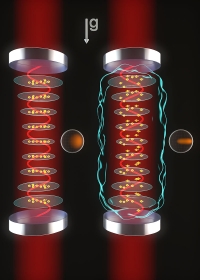James Thompson
Winchester
Matthew worked on the strontium superradiant laser experiment from fall 2013 until summer 2017. He was awarded a Goldwater Scholarship in 2016! He majored in Engineering Physics, and successfully completed an honors research project on superradiant lasers and graduated in 2017.
Picozzi
Elissa Picozzi was an REU student during the summer of 2014. She developed a homodyne detector for next generation spin squeezing experiments. She is currently a Junior at Whitman College.
Moses
Steven Moses was an REU student during the summer of 2008. He helped to build the microwave electronics used to precisely manipulate the quantum state of Rubidium atoms. Steven returned to JILA/University of Colorado to pursue his PhD in physics. He did his PhD degree on KRb mixtures in the group of Jin and Ye. He then went on to a postdoc with Chris Monroe at the University of Maryland. He is currently at Quantinuum.
McAlpine
Katie was an REU student during the summer of 2012 when she worked to develop low noise photodiodes for spin squeezing experiments. She is currently working toward her PhD in physics, having joined the group of Subhadeep Gupta at the University of Washington.
Barker
Daniel Barker was an REU student during the summer of 2007, working to build AOM sources for the rubidium system. He is currently at the University of Maryland, where he is nearing completion of his PhD in physics working with Gretchen Campbell.
Weiner
Josh successfully defended his PhD thesis in 2015 titled "Synchronization and Sensing with Steady State Superradiance and Spin Squeezing." He currently works for WyzAnt, Inc.
Norcia
Matt graduated in August 2017. He went on to work with Adam Kaufman at JILA as an NRC postdoctoral fellow. Matt helped to start a strontium tweezer experiment and demonstrated a tweezer clock among other accomplishments. Matt then moved to IQOQI to work with Francesca Ferlaino on quantum droplet experiments in dysprosium. He is now working at Atom Computing in Boulder on tweezer-based quantum computing.
Dia
Phoenix was a graduate student working on the Rubidium experiment. She has since joined the group of John Kitching at NIST, building optical magnetometers.



 The Physics Frontiers Centers (PFC) program supports university-based centers and institutes where the collective efforts of a larger group of individuals can enable transformational advances in the most promising research areas. The program is designed to foster major breakthroughs at the intellectual frontiers of physics by providing needed resources such as combinations of talents, skills, disciplines, and/or specialized infrastructure, not usually available to individual investigators or small groups, in an environment in which the collective efforts of the larger group can be shown to be seminal to promoting significant progress in the science and the education of students. PFCs also include creative, substantive activities aimed at enhancing education, broadening participation of traditionally underrepresented groups, and outreach to the scientific community and general public.
The Physics Frontiers Centers (PFC) program supports university-based centers and institutes where the collective efforts of a larger group of individuals can enable transformational advances in the most promising research areas. The program is designed to foster major breakthroughs at the intellectual frontiers of physics by providing needed resources such as combinations of talents, skills, disciplines, and/or specialized infrastructure, not usually available to individual investigators or small groups, in an environment in which the collective efforts of the larger group can be shown to be seminal to promoting significant progress in the science and the education of students. PFCs also include creative, substantive activities aimed at enhancing education, broadening participation of traditionally underrepresented groups, and outreach to the scientific community and general public.